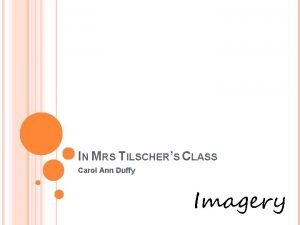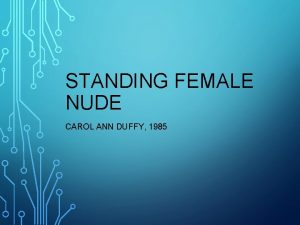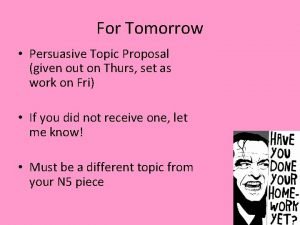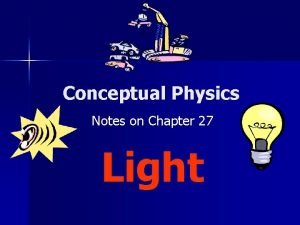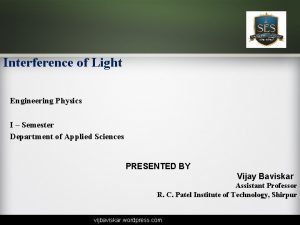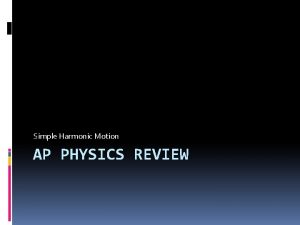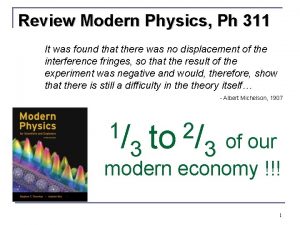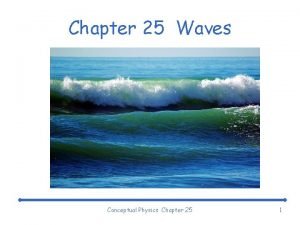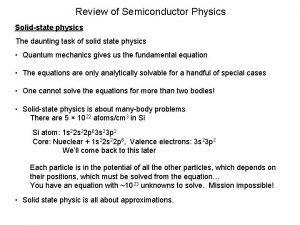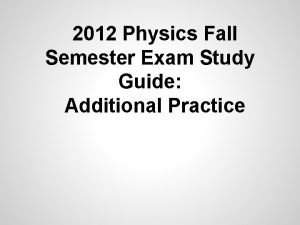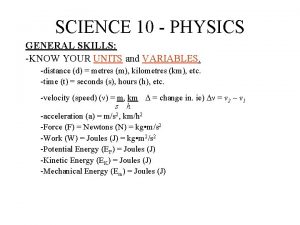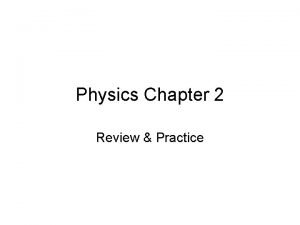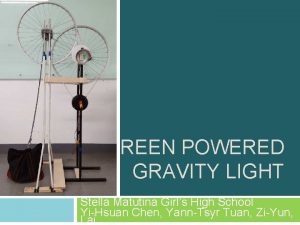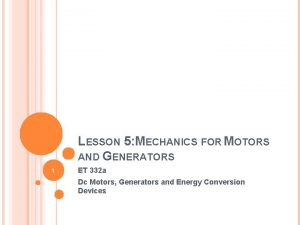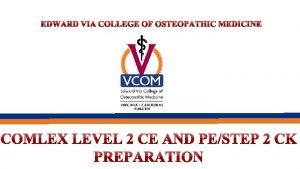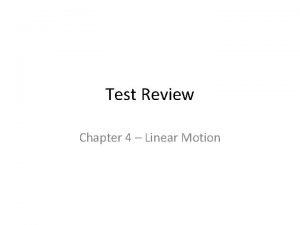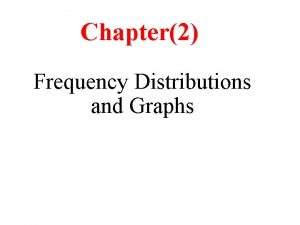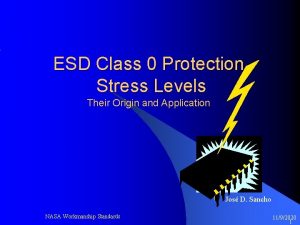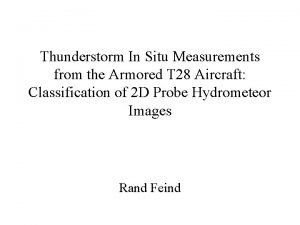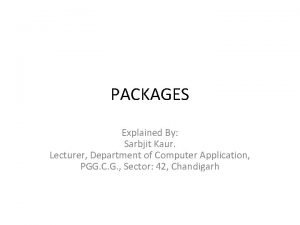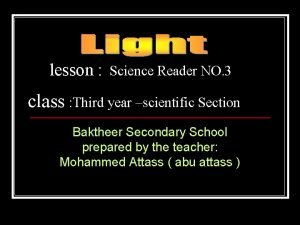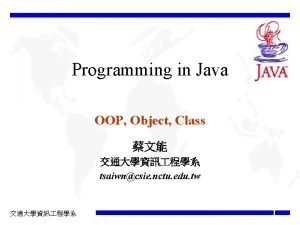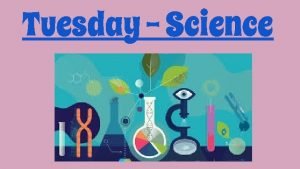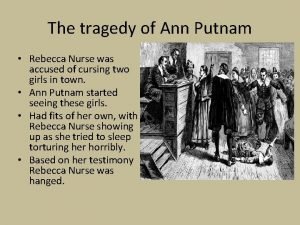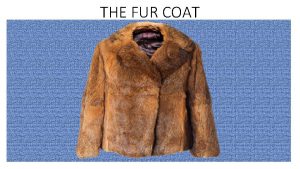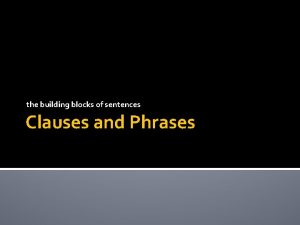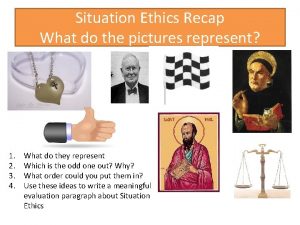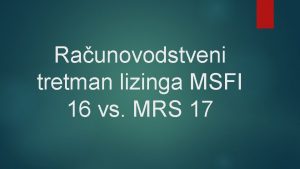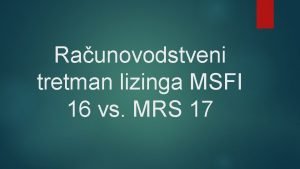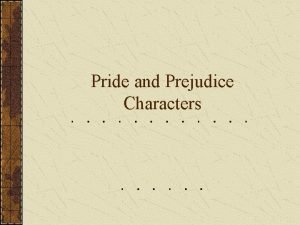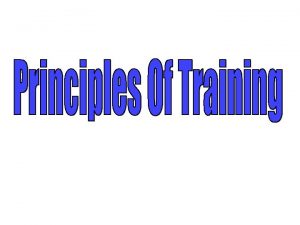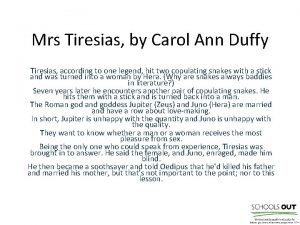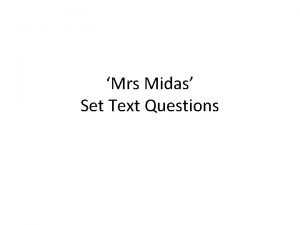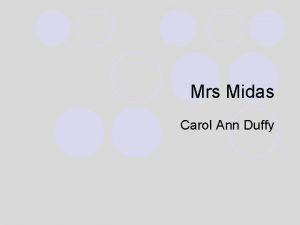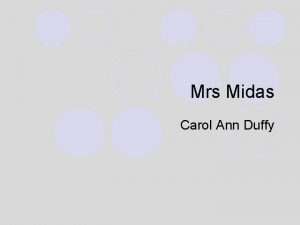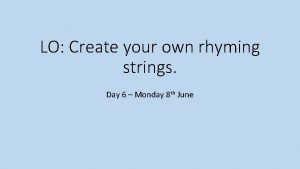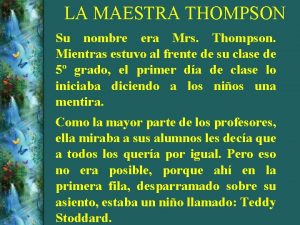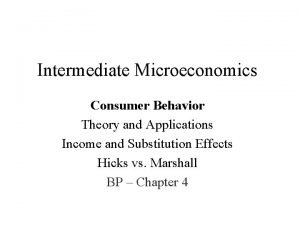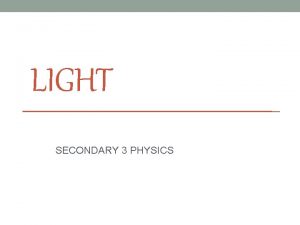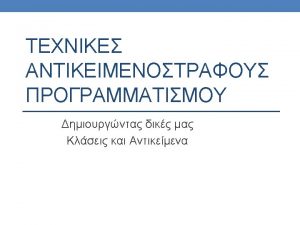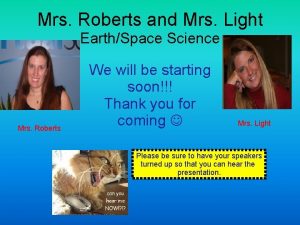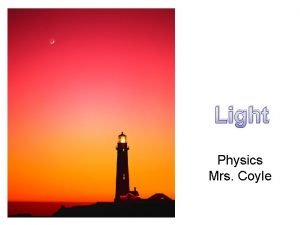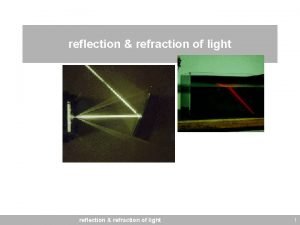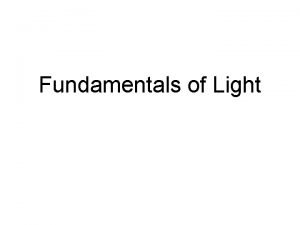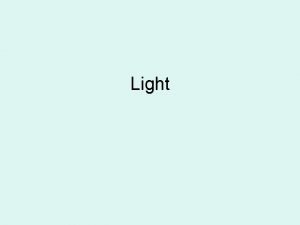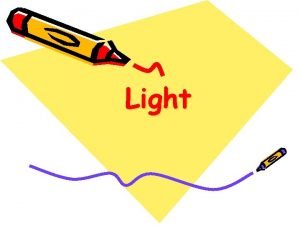Light Mrs Warrens Physics Class 1 Review From















































































































- Slides: 111

Light Mrs. Warren’s Physics Class 1

Review From Previous Week • Wave Particle Duality • Types of Waves – Discuss each… • Wave Characteristics • Boundary Behavior – How many boundary types did we talk about? – Let’s describe all of them! Interference? What is that? 2

Speaking of Interference • Constructive Interference – Comes together to make a larger, stronger wave (what specifically increases? ) • Destructive Interference – Comes together to cancel each other out or maker a weaker wave (what decreases in this case? ) 3

Interference • Because light is made up of many colors it is easy for us to see interference on something such as BUBBLES!!!!! • Who doesn’t love bubbles, right? 4

Lab Time! • Objectives for Lab: – Understanding/visualizing constructive and destructive interference. – Making and recording observations. – Drawing Conclusions/ Making Inferences 5

INSTRUCTIONS! • Everyone grab a plastic plate • 1 straw • Cut a piece of black plastic trash bag that is similar to the size of the one Mrs. Warren shows you. • Grab a strip of white paper. 6

Instructions • Wet the larger section of your plate with only a little bit of water and stick the black plastic trash bag to it. • Mrs. Warren will pass around the soap solution and pour a little solution into your plate. 7

Instructions • Take your straw and dip the straw into your soap solution to make a big bubble. (without it popping!) – Do not drink the soap solution. I know how much you love to drink soap…but it’s gross! • Observe the top of the bubble very VERY closely. – Describe what you see. 8

Instructions • When the bubble pops, blow another big bubble. • Now try to put the white paper around the bubble without touching the bubble. – This may help you see things a little more clearly. Describe what is happening with the bubble (specifically look on top of the bubble) Write this down! 9

Questions About Lab • 1. The colors you see at the top of the bubble is called a “fringe. ” Describe what they looked like. • 2. Why are there many colors? Do you see all colors, or are there more of one color? Why would there be more of one color? • 3. What are the dark bands? • 4. Can you see evidence of constructive and destructive interference? Explain. • 5. What determines what the fringes look like? • 6. What happens right before the bubble pops? Why do you think that is? 10

Discussion • The colors we see on the bubbles are caused by ________ of white light shining on the bubble film. • White light has many colors and each of these colors have different wavelengths. – Remind me what a wavelength is again? Mrs. Warren just forgot! OH NO! 11

Discussion • What do the fringes look like? What are they doing? 12

Discussion • What makes up the dark circle in the middle of the bubble? How would this explain evidence of destructive interference? 13

Discussion 14

Discussion • It is easy to see destructive interference because of the dark bands or circles. • But how do we know we have constructive interference? – If we wanted to measure how much constructive interference we have we could with a ruler!!! 15

Discussion • Why do you think we even see interference on a bubble? 16

Discussion • Describe thickness of a bubble. – This type of interference is called: Thin Film Interference. – Light waves bounce off the front and back surfaces of the bubble to add constructively or destructively. – Thickness is not uniform around the bubble, this is why you see the swirling of colors and a black circle on top, which ultimately leads to the inevitable death of the bubble!! 17

Review • What is interference? • What is constructive interference? • What is destructive interference? 18

Standing Waves Continuous Wave vs. Standing Wave – What do you think the difference is? • Hint: We have been talking about continuous waves…not standing. 19

Standing Waves • What is a standing wave? – A wave that appears to be standing still. – Generating a wave, but the wave doesn't propagate. – Examples: Vibrating a string or cord. – Standing Wave vs. Moving Wave – We need to look at what a node and antinode are. 20

Standing Waves 21

Standing Waves • Why do Standing Waves Appear to Stand Still? – Reflected vibrations from the opposite end of the medium will interfere with vibrations introduced into the medium in such a manner that there are points that always appear to be standing still. • What happens if timing is off? 22

Standing Waves • Nearly all objects, when hit, struck or somehow disturbed, will vibrate. – Tend to vibrate at a particular frequency or a set of frequencies. • Known as Natural Frequency 23

Standing Waves • Wave patterns could be produced by a distinctly different number of nodes. • Each frequency is associated with a different standing wave pattern. – Called Harmonics. 24

Standing Wave Examples 25

Problem 26

Solution 27

Standing Waves • How do Standing Waves have anything else to do with the world other than music? • Famous Bridge, Tacoma Narrows Bridge • Let’s watch a video about what happened. http: //www. schooltube. com/video/e 43 30 c 5 f 2 c 4 d 6 d 15093 c/Galloping-Gertie 28

Tacoma Narrows Bridge 29

Tacoma Narrows Bridge • What happened? • The original, 5, 939 -foot-long Tacoma Narrows Bridge, was opened to traffic on July 1, 1940 after two years of construction, linking Tacoma and Gig Harbor. • It collapsed 4 months and 7 days after it opened. The collapse occurred during a 42 -mile-per-hour wind storm on November 7, 1940, around 11: 00 am. 30

Tacoma Bridge • When a structure is vibrating with its fundamental frequency, then all the particles oscillate in phase with the same frequency. • At resonance, the amplitude of the standing wave increases without limit, until the structure is damaged. – What is resonance? – Think of music…. singing in the car to your radio 31

What’s Going On Now • We have finished talking about wave characteristics and behaviors. • The information next presented is going to be a combination of the end of Chapter 14, Chapter 16, and Chapter 17. • So LET’S TALK ABOUT LIGHT!!!! • YOU…. LIGHT UP MY LIFE…. YOU LIGHT UP MY DAYS… (sorry broke out in song again) 32

Objectives • You will learn the parts of the electromagnetic spectrum and what the electromagnetic spectrum means. • You will learn how light behaves. • You will learn how to describe the ray model of light. • You will be able to solve problems involving the speed of light. • HERE WE GO………. 33

Light • What is LIGHT? – Discussion 34

What is Light? • Light is a wave, or rather acts like a wave. • More specifically, light is the range of frequencies of electromagnetic waves that stimulates the retina of the eye. • Light waves have wavelengths from about 400 nm to 700 nm. 35

What is Light • Light is a special type of wave (you should know this type of wave already…what do we think? ) • What medium is light transferred through? • LIGHT DOES NOT NEED ONE! • What we know as light or VISIBLE LIGHT is actually a type of something called ELECTROMAGNETIC RADIATION. 36

Electromagnetic Waves • EMR – a form of energy that exhibits wave behavior due to electric and magnetic fields. • Depending on the amount of energy, the object will emit different types of electromagnetic radiation. 37

Electromagnetic Waves Electromagnetic waves can be imagined as a self-propagating, continuous, transverse wave of electric and magnetic fields. This diagram shows a wave propagating from right to left. The electric field is in a vertical plane and the magnetic field in a horizontal plane. 38

Electromagnetic Waves • Electromagnetic waves are special in the fact that they do not need a medium to propagate through. • But what is creating the disturbance? What is emitting this energy? • ELECTRONS 39

Electromagnetic Waves • Electrons in materials are vibrated and emit energy in the form of photons, which propagate across the universe. • Photons have no mass, but are pure energy. • Electromagnetic Waves are waves that are made up of these “photons”. • When these photons come in contact with boundaries, E-M waves interact like other waves would. 40

Electromagnetic Waves • Electromagnetic waves are everywhere. • Light is only a small part of them What other categories of electromagnetic waves do you know? 41

Electromagnetic Spectrum 42

Radio Waves • Longest Wavelengths • Football Field Length or Longer • Can You Hear Me Now? TV, Radio, Comets, Planets 43

AM and FM Radio Waves • Amplitude modulation, or AM, stations code information in the carrier wave by changing, or modulating, the amplitude. • In contrast, frequency modulation, or FM, stations alter the frequency of the carrier signal. 44

Microwaves • Wavelengths are measured in cm! • The longer wavelengths in this region are the ones that heat our food! • Doppler Radar • Telephone Calls • Laptop Information 45

Infrared Light • Range of Wavelengths • Near and Far IR • Far – thermal – Sunlight, fire, etc. • Humans radiate most strongly in IR. • Can’t see IR waves…ewww…sna kes! 46

Visible Light • What we see!!! • ROY G. BIV • Red is the longest wavelength • Violet is the shortest wavelength • All waves together = white light – Prism – Water Vapor 47

Visible Light • Cones in our eyes are receivers for visible light. • Sun and Light bulbs are natural sources • The color we see is the color of light reflected while all other colors are absorbed. 48

Ultraviolet Radiation • Distinguished by Energy not Wavelength. • Humans cannot see, but some insects can. • Near UV, Far UV, Extreme UV • Sunlight – UV light – burns • Study structures and evolution of galaxies. 49

X-Rays • More like particles than waves. • 1895 – Wilhelm Conrad Roentgen • Why do we call it “X” rays? • Like a shadow. • Doesn’t penetrate bone and metal. 50

X Rays 51

Gamma Rays • Smallest wavelength. • Generated by Radioactive Atoms or Nuclear Explosions. • Can kill living cells • Produced by hottest regions. • High Incidence of Cancer – Affects DNA • CT Scans 52

CT Scan Discussion • Will getting two or three CT scans of the abdomen expose you to the same amount of radiation as people who lived near the atomic blast that ravaged Hiroshima in 1945 but survived? 53

CT Scan • What’s the problem with CTs? • What’s the benefits of CT scans? -Let’s Discuss Case Study 54

CT Scans • Homework – Bring in 2 articles about CT Scans and their benefit or risk to society. – 50 points – Read both articles and be prepared to discuss implications of technology and radiation such as CT scans. – Debate Tuesday. (You will be given a team Tuesday, but you should be prepared for both arguments) 55

CT Scans • CT scanning—sometimes called CAT scanning—is a noninvasive medical test that helps physicians diagnose and treat medical conditions. • CT scanning combines special x-ray equipment with sophisticated computers to produce multiple images or pictures of the inside of the body. • CT scans of internal organs, bones, soft tissue and blood vessels provide greater clarity and reveal more details than regular x-ray exams. 56

CT Scans 57

CT Scans • Physicians often use the CT examination to: – quickly identify injuries to the lungs, heart and vessels, liver, spleen, kidneys, bowel or other internal organs in cases of trauma. – guide biopsies and other procedures such as abscess drainages and minimally invasive tumor treatments. – plan for and assess the results of surgery, such as organ transplants or gastric bypass. – stage, plan and properly administer radiation treatments for tumors as well as monitor response to chemotherapy. – measure bone mineral density for the detection of osteoporosis. 58

CT Scans • 72 million scans a year, according to a 2009 study from the Archives of Internal Medicine. • Radiation doses vary wildly. Some patients who underwent the same type of test received 20 times more radiation than others, often in the same hospital. • Standards? • A new study from the National Cancer Institute projects 29, 000 excess cancers from the 72 million CT scans that Americans got in 2007 alone. Nearly 15, 000 of those cancers could be fatal. 59

Light • Objectives 60

Just the Facts Ma’am • Light travels in a straight line in a vacuum or other uniform medium. • Our brains locate objects by automatically assuming light travels from objects to our eyes along a straight path. 61

Ray Model of Light • Straight Line Path of Light • A ray is a straight line that represents the path of a narrow beam of light. • This study of light rays in straight lines is called ray optics. • (Ignores wave behavior) 62

Ray Model of Light 63

All Models of Light 64

Speed of Light • Before 17 th century, light travels instantaneously. • Galileo was first to hypothesize light had a specific speed. – His experiment is something you could do! – What is wrong with his method? • Ole Roemer – First to determine speed of light at a measurable speed. – Jupiter’s Moons 65

Speed of Light Calculation • Albert A. Michelson – Michelson and Morley Experiment – Ether? • So mysterious!! 66

Speed of Light Albert A. Michelson – Measured time required for light to make a round trip between 2 California mountains 35 km apart. – 2. 99799 x 108 m/s – First American to receive Nobel Prize in science. 67

Speed of Light • In 1960 the development of the laser provided new methods of measuring the speed of light. • The International Committee of Weights and Measurements in 1983 made the speed of light a definite quantity. 68

Speed of EM Waves • From last chapter, we found that – V=f*l • We also said that the speed of a wave in a certain medium is always constant. • It has been found that the speed of EM waves and light is --– 3 x 108 or 300, 000 m/s – 671, 000 mph – 186, 000 miles per second – We call this value “c” 69

HOLD YOUR HORSES! • Confusion!!! • Let’s clear that up now! • Speed of Light vs. Colors of Light 70

c=f*l • C is constant throughout the universe, as long as light is in a ________. • When it is in other materials, c can change, but can never be larger than its value in a vacuum. • Since “c” is constant, all of EM waves will have a corresponding frequency to go along with their wavelength. 71

Problems • What is the frequency of yellow light if lamda = 556 nm while traveling in a vacuum? 72

Problems • Modern lasers can create a pulse of light that lasts only a few femtoseconds (fs). What is the length of a pulse of violet light that lasts 6. 0 fs in a vacuum? 73

Problems • The distance to the moon can be found with the help of mirrors on the moon by astronauts. A pulse of light is sent to the moon and returns in 2. 562 seconds. Calculate distance from Earth to moon. 74

Sources of Light • Without light, there would be no sight. 75

Sources of Light • What’s the difference between sunlight of moonlight? 76

Sources of Light • There is an important fundamental difference between the sun and the moon. – The sun is a luminous body – The moon is an illuminated body – What do you think that means? 77

Sources of Light • A luminous body emits light waves. • An illuminated body simply reflects light waves produced by an outside source. • Other examples: – Bicycle Reflector – Incandescent Lamps (light-bulb) 78

Sources of Light • During the evening when the Earth has rotated to a position where the light from the sun can no longer reach our part of the Earth (due to its inability to bend around the spherical shape of the Earth), objects on Earth appear black (or at least so dark that we could say they are nearly black). 79

Luminous Flux • The rate at which visible light is emitted from a source is called the LUMINOUS FLUX, P. • The unit of luminous flux is the lumen, lm. • A typical 100 watt incandescent light -bulb emits 1750 lm. • Let’s think of this as the total perceived power emitted in all directions. 80

Luminous Intensity • Some light sources are specified in candela, cd, or candle power. • The luminous intensity of a point source is the luminous flux that falls in one particular area. 81

HUH? • How is luminous intensity different than flux? – Intensity is the perceived power in a particular direction. Flux is the power in ALL directions. 82

Illuminance • The illumination of a surface is called the illuminance, E, and it is the rate at which light falls on a surface. • This is measured in lumens per square meter. • lm/m 2 = lux, lx. 83

How to Illuminate a Surface • 2 ways to increase the illumination on a surface. – Use a brighter bulb (what would this do? ) – Move the surface closer to the bulb (why would this help? ) 84

Illuminating a Surface • The illuminance can be mathematically calculated by the following formula: • This equation is only valid if the light from the source strikes the surface perpendicular to it. 85

Illumination of a Surface • Consider a 100 watt lightbulb in the middle of a sphere. What is the illumination of the sphere’s surface at a distance of 1 meter from the bulb? • P = 1750 lm, d = 1 m 86

Illumination of a Surface • What happens if the distance is 2 m? • How does the denominator change? 87

More Examples • What is the illumination on your desktop if it is lighted by a 1750 lumen lamp that is 2. 50 m above your desk? 88

• Your Turn! 89

c = f * l ~~~ f = c / l • Lets find the corresponding frequency ranges for a few of the groups of E-M waves. © 2003 Mike Maloney 90

Energy in E-M Waves • Which waves have more energy, Radio waves or gamma waves? • The greater the frequency of an E-M wave, the more crests pass a point in a certain amount of time, therefore the more photons pass that point. • This means that more energy moves past that point in a certain amount of time or that the wave contains more energy. © 2003 Mike Maloney 91

Back to Light • So, why can we only see a small portion of these E-M waves? © 2003 Mike Maloney 92

Our Eyes © 2003 Mike Maloney 93

Visible Light • We now know what we see is part of the electromagnetic spectrum. We know that the light waves enter our eye, and stimulate parts of it that cause a electrical impulse to be sent to the brain which creates this visual image. • But everything does not emit radiation. How do we see those things? And why cant we see a window? © 2003 Mike Maloney 94

Seeing things • We know that when waves run into a boundary they are partially transmitted and partially reflected. • Light behaves as a wave, so it to is reflected. • Therefore, an object does not need to emit photons itself to be seen, it just has to reflect light back to our eyes where we can detect it. • Objects that do not allow light to pass through them are called opaque. • Objects that allow light to pass through them are considered transparent. • Objects in between are called translucent. © 2003 Mike Maloney 95

Polarization • Polarization is a phenomenon of light that is used in sun-glasses and 3 -D movies. • Play with the two polarizing filters for a few minutes and note what is happening and see if you can think of any reasons for it. © 2003 Mike Maloney 96

Polarization Hint • Light vibrates in all directions. • A polarizing filter acts like a picket fence. It only lets certain direction vibrations pass through it. • Therefore, if you pass light through two of them you can completely block the light from passing through. • HOW? © 2003 Mike Maloney 97

Polarization © 2003 Mike Maloney 98

Color • Different objects may emit different wavelengths of E-M radiation, so we would see that light as different colors. • But why do we see colors in objects that reflect light? If you shine a white light on my clothes, and it gets reflected why doesn’t all of my clothes appear white? • When I shine white light through a colored piece of plastic, why does it change color? © 2003 Mike Maloney 99

Color • The light we see is know as visible or white light – although it is not that simple. • The light is not really white, the white we see is a combination of all the colors of the rainbow. • Remember R-O-Y G. B-I-V from art class. • When all of these light waves are combined we see white light. © 2003 Mike Maloney 100

Color Reflection • So if we see something as WHITE, that means … – It reflected back all the wavelengths of light to our eyes • If we see something as RED or BLUE – It reflected only the RED or only the BLUE wavelengths – The others were absorbed. • And if we see something as black? – It did not reflect back any of the light. © 2003 Mike Maloney 101

Color Transmission • Filters work in a similar way. – Red filters only let RED light thru. – Blue let only BLUE light thru. • What do you think that UV sticker means on your sunglasses? • Why do they sell those orange glasses that are supposed to reduce glare? © 2003 Mike Maloney 102

Some Sweet Color Tricks • • Combining colors in art class How does color printing work? Combining lights Why is the sky blue? Why are sunsets red? Why is water greenish-blue? How does 3 -D work? Why does a CD reflect a rainbow, and a mirror does not? • How can you help people who are color blind? • OTHERS link to site © 2003 Mike Maloney 103

Flux • We now know how light behaves, but we must measure how strong it is. • The rate at which a source emits light is called the LUMINOUS FLUX (P). • What do you think this is measured in? What are light bulbs measured in. • LUMINOUS FLUX (P) is actually measured in something called a lumen (lm). • A typical 100 -W bulb emits 1750 lm. © 2003 Mike Maloney 104

Illuminance • Flux is the total of all the light that is emitted from a source. • This is not very useful, often we would like to know how much of that light is hitting a surface at some point. • The illumination of a surface is called illuminance, E. It is measured in lumens per square meter, lm/m 2 © 2003 Mike Maloney 105

Illuminance • How do you think illuminance is affected when the object moves away from the source? – Right the illuminance decreases • So what would you expect an equation to look like for E in terms of P and the distance away d? – Close it is actually P E = 4 Pd 2 © 2003 Mike Maloney 106

© 2003 Mike Maloney 107

Electromagnetic Spectrum BACK © 2003 Mike Maloney 108

BACK © 2003 Mike Maloney 109

BACK © 2003 Mike Maloney 110

BACK © 2003 Mike Maloney 111
 Light light light chapter 23
Light light light chapter 23 Light light light chapter 22
Light light light chapter 22 Chapter 22
Chapter 22 They are mrs garcia and mrs castro
They are mrs garcia and mrs castro They are mrs garcia and mrs castro
They are mrs garcia and mrs castro Mrs. darling was ___________ of mrs. s.
Mrs. darling was ___________ of mrs. s. Mrs tilscher's class analysis
Mrs tilscher's class analysis In mrs tilscher's class analysis
In mrs tilscher's class analysis In mrs tilscher's class structure
In mrs tilscher's class structure In mrs tilscher's class
In mrs tilscher's class Mrs tilscher's class
Mrs tilscher's class Mrs tilscher's class annotated
Mrs tilscher's class annotated Mrs edgar teacher planner
Mrs edgar teacher planner Mrs lazarus genius
Mrs lazarus genius Mrs dalys reading classes
Mrs dalys reading classes In mrs tilscher's class annotated
In mrs tilscher's class annotated In mrs tilscher's class annotated glow
In mrs tilscher's class annotated glow Standing female nude poem
Standing female nude poem Modern physics vs classical physics
Modern physics vs classical physics University physics with modern physics fifteenth edition
University physics with modern physics fifteenth edition Physics ia exemplars
Physics ia exemplars Chapter 27 light
Chapter 27 light Interference of light engineering physics
Interference of light engineering physics Put out the light and put out the light
Put out the light and put out the light Membrane-bound organelles
Membrane-bound organelles The bouncing off of light
The bouncing off of light What materials do block light
What materials do block light Restoring force physics
Restoring force physics Review of modern physics
Review of modern physics Physics review letter
Physics review letter Physics semester 1 review
Physics semester 1 review Conceptual physics chapter 25
Conceptual physics chapter 25 Fcc wigner seitz cell
Fcc wigner seitz cell Physics 20 final exam practice
Physics 20 final exam practice Physics fall semester exam review
Physics fall semester exam review Science 10 physics review
Science 10 physics review Physics chapter 2 review
Physics chapter 2 review Physics 1 exam 2 review
Physics 1 exam 2 review Physics exam 2 review
Physics exam 2 review Like terms algebra
Like terms algebra Describe the one color method for applying light cured gels
Describe the one color method for applying light cured gels Gravity light diy
Gravity light diy Chapter review motion part a vocabulary review answer key
Chapter review motion part a vocabulary review answer key Uncontrollable spending ap gov
Uncontrollable spending ap gov Narrative review vs systematic review
Narrative review vs systematic review Narrative review vs systematic review
Narrative review vs systematic review Narrative review vs systematic review
Narrative review vs systematic review Units of torque
Units of torque Comlex level 2
Comlex level 2 Chapter 4 test linear motion answer key
Chapter 4 test linear motion answer key In todays lesson
In todays lesson Package mypackage class first class body
Package mypackage class first class body Difference between abstract class and concrete class
Difference between abstract class and concrete class Mean median mode grouped data exercises
Mean median mode grouped data exercises Class i vs class ii mhc
Class i vs class ii mhc Difference between abstract class and concrete class
Difference between abstract class and concrete class How to get the class mark
How to get the class mark Stimulus
Stimulus Stimuli vs stimulus
Stimuli vs stimulus Therapeutic class and pharmacologic class
Therapeutic class and pharmacologic class Class maths student student1 class student string name
Class maths student student1 class student string name Categorical frequency distribution example
Categorical frequency distribution example In greenfoot, you can cast an actor class to a world class?
In greenfoot, you can cast an actor class to a world class? Static and dynamic class loading in java
Static and dynamic class loading in java Esd class 0
Esd class 0 Analysis level class diagram
Analysis level class diagram Class 2 class 3
Class 2 class 3 Public class test subject extends test class
Public class test subject extends test class Package mypackage class first class body
Package mypackage class first class body Class third class
Class third class Www.classpointapp
Www.classpointapp Component class has composite class as collaborator
Component class has composite class as collaborator Ttsmp.3
Ttsmp.3 Wuthering heights summary chapter 10
Wuthering heights summary chapter 10 Character sketch of margie
Character sketch of margie Ms turnbull history
Ms turnbull history Mrs williams google classroom
Mrs williams google classroom Mrs weinstein's popcorn
Mrs weinstein's popcorn Mrs mulch
Mrs mulch Crocodile on the loose poem by mrs prejna
Crocodile on the loose poem by mrs prejna Mrs gren stands for
Mrs gren stands for Ann putnam and rebecca nurse
Ann putnam and rebecca nurse 10 marker structure
10 marker structure Mrs skeletal
Mrs skeletal Great gatsby chapter 1-6 summary
Great gatsby chapter 1-6 summary The fur coat by sean o'faolain
The fur coat by sean o'faolain Who lives next door to rob independent or dependent
Who lives next door to rob independent or dependent Mrs bergmeier
Mrs bergmeier Mrs bergmeier
Mrs bergmeier Kiss of the vampire poster representation
Kiss of the vampire poster representation The twits character description extract
The twits character description extract Mrs 17
Mrs 17 Mrs 17
Mrs 17 Pride and prejudice mrs lucas
Pride and prejudice mrs lucas World's constable cartoon
World's constable cartoon Mrs palmieri
Mrs palmieri Mrs vopp
Mrs vopp Mrs tiresias
Mrs tiresias Mrs midas questions
Mrs midas questions Mrs lazarus analysis
Mrs lazarus analysis Mrs. midas poem
Mrs. midas poem Mrs hunter day
Mrs hunter day What is mrs gren in science
What is mrs gren in science Define object pronouns
Define object pronouns Carol ann duffy mrs aesop
Carol ann duffy mrs aesop Mrs waldron teacher
Mrs waldron teacher Mrs quann
Mrs quann Whom had macbeth and banquo been fighting?
Whom had macbeth and banquo been fighting? Mrs sprockett's strange machine
Mrs sprockett's strange machine La profesora thompson
La profesora thompson Diminishing mrs
Diminishing mrs Msfi 9 primjer
Msfi 9 primjer









